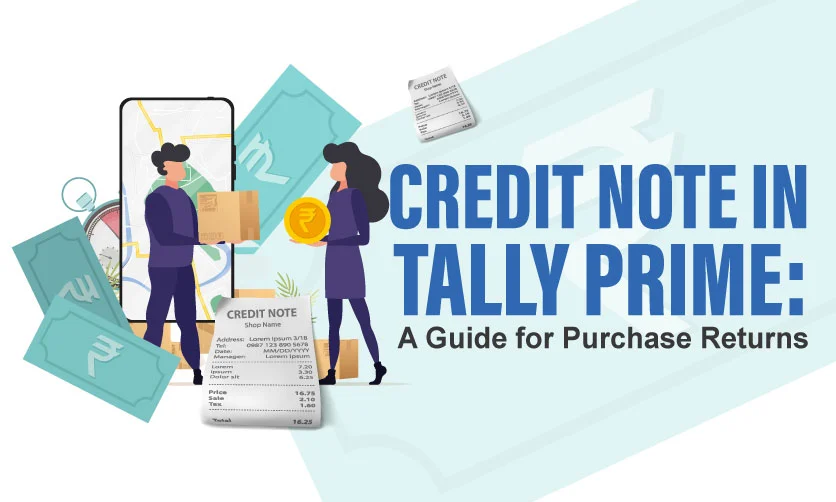
Credit Note in Tally Prime: A Guide for Purchase Returns
Have you ever generated credit notes in your business? Do you have any idea about credit notes or how to generate credit note in Tally Prime, if you are using Tally Prime to manage your accounts?
Don’t worry, we are here to answer all your queries and explain credit note entries in Tally Prime. Why it is needed when to issue them, and more here in the blog.
In the dynamic business landscape, sometimes business transactions don’t go smoothly. It means, there is a chance that the goods you received might be damaged in transit, received in the wrong quantity, or not meet your expectations.
In such cases, businesses usually return goods and formally inform the supplier to adjust financial records accordingly. This is where credit notes come into action. Let’s dive, into understanding the in-depth concepts of credit notes and creating credit notes in tally prime.
Table of Contents
Why Credit Notes?
I hope you have an idea about the Credit notes. Let’s understand, Why businesses need to generate credit notes:
- Maintaining Accurate Records: The first primary reason for issuing a credit note is to reflect the return of goods. Simultaneously, it will update your accounts payable and inventory levels. This will ensure that your financial statements match your current financial position.
- Transparency and Legality: Credit notes help create a sense of transparency and serve as a legal document between supplier and buyer. The credit note validates the return of goods and the reduction in the purchase price. This document protects both parties from potential disputes.
- Streamlined Refunds: When the buyer issues a credit note, the supplier receives a notification for the same. The supplier is aware of the returned goods and the revised amount that needs to be refunded.
- Improved Customer Relationships: Promptly issuing a credit note for valid returns demonstrates good customer service. Even this helps to build trust between your business and its suppliers.
What is a Credit Note?
A credit note, also called a credit memo, is a commercial document issued by a buyer to a supplier. This document represents the details of the previously purchased goods that are going to be returned.
In addition to that, it reflects a reduction in the original invoice amount. Essentially, it serves as a negative invoice, reflecting a decrease in the buyer’s outstanding debt to the supplier.
We have briefly discussed the credit note and why it is needed. Before moving to the credit note in tally prime, let’s explore the conditions when a credit note is issued.
You can also read more about the Tally-related articles here:
When Should I Issue a Credit Note?
Check out all the cases mentioned, when businesses typically generate credit notes:
- Purchase Returns: This condition is initiated when a buyer returns purchased goods due to damage, defect, or incorrect quantity.
- Price Discrepancies: If the supplier charges the price more than the agreed price. In this case, a credit note can be issued to adjust the price and reflect the correct amount payable.
- Cash Discounts Missed: In case a buyer misses a cash discount deadline, but the supplier is willing to extend it. In such a scenario, to adjust the invoice amount and show the discounted price, a credit note can be created.
- Promotional Offers: Sometimes, after purchasing, the supplier offers a post-purchase discount or rebate. In this situation, a credit note can be issued to reduce the invoice amount accordingly.
Till now, we have tried to clarify your basic concept of credit notes. Moving forward, we will discuss credit notes for purchase returns and how to generate credit note entries in Tally Prime.
Credit Note For Purchase Return
We have mentioned a few cases above when credit notes can be issued. Here we will discuss in detail credit notes for purchase returns and how to create credit notes in tally prime with real-life cases.
Real-Life Case Scenario: Handling a Purchase Return with a Credit Note
Let us consider that Shyam is running a bakery shop. He recently placed an order with a flour supplier for 100 kg of all-purpose flour. When Shyam received the delivery, he discovered that by mistake supplier sent 50 kg of whole wheat flour instead.
Now, after finding the discrepancy, Shyam wants to return the received wheat floor. Let’s see how Shyam started the process of creating credit notes in Tally Prime and informed the supplier.
Here’s how Shyam will address this situation:
- Contact the Supplier: Firstly, Shyam has to inform the supplier about the wrong order he received from them. Also, he informs them that due to the default order, he will return the whole wheat flour.
- Gather Documentation: Shyam even maintains a copy of the original purchase invoice and other communication details with the supplier regarding the discrepancy. So that if needed in the future, he will use it.
Now you can analyze the situation and need to create the credit note in tally prime. In the next section, we will describe the step-by-step process for credit note entry in tally prime.
If you are interested in learning the complete tally course, then explore here:

Credit Note For Purchase Return: A Step-by-Step Guide in Tally Prime
Here, we have described each step for creating a credit note in Tally Prime for purchase return. We will describe the step of credit note entry in tally prime with the help of the above example. This will help you to understand the core concept easily.
#1: Accessing Credit Note Feature
The first step for generating credit note entries in Tally Prime is to enable the credit note feature. Follow the mentioned steps and start the process:
- Go to Gateway of Tally > Vouchers > Create Voucher. Alternatively, use the shortcut key Alt+G followed by F10 and select Credit Note.
#2: Select the Invoice Mode (Optional)
This step is optional for Shyam while creating a credit note in Tally Prime. But for better clarification, Shyam has selected this step:
- Here, there are two options available for Shyam to initiate credit notes in Tally Prime. He can choose either to create credit notes in Voucher Mode or Invoice Mode. If Shyam selects the voucher mode, then the process is simple for creating credit notes.
- If Shyam chooses invoice mode, then it allows Shyam to create credit note entries in Tally Prime with more detailed information like tax calculations.
#3: Enter Credit Note Details
In this step, Shyam needs to enter the following credit note details:
- Party: Firstly, choose the supplier from the supplier lists. Here, Shyam will select from whom Shyam has purchased the goods
- Date: Fill in the date of issuing the credit note.
- Narration: Here, Shyam needs to enter the reason for returning the goods. (For example, “Damaged goods received” or “Incorrect quantity purchased”). The reason varies according to the buyer’s situation. Here, for example, Shyam will enter Wrong Product Received.
#4: Add Inventory Items
In this step, Shyam has to enter the complete inventory detail for creating a credit note entry in tally prime
- Shyam will choose the specific inventory items being returned. For example, wheat here.
- Enter the quantity of each item being returned. Here, Shyam will enter 50 Kg.
- If using Invoice Mode, you can specify the rate per unit, but it will automatically populate based on the original purchase price.
- Tally Prime will automatically calculate the total credit amount based on the quantity and unit price.
#5: Verify and Save
This is the verification step:
- Once Shyam enters all the details, He will review the complete credit note details for accuracy. If everything is correct, then he can save the voucher.
#6 Additional Considerations
The last step, where Shyam has the option to add more details :
- Shyam can attach documents like photos of the received wrong item or copies of communication with the supplier to support the return.
- Once you attach all the details, Tally Prime gives you the option to print the credit note and send it to the supplier for their records.
If you follow all the steps mentioned above accurately while creating a credit note in Tally Prime then there is a lower chance of errors. Meanwhile, I hope you have read each step carefully and that the concepts of credit note entry in Tally Prime are clear to you.
If you are looking to read some more relevant articles on Tally Prime, then read the articles here:
In our previous article, we explained debit notes in Tally Prime. If you are confused about why we have not chosen debit notes here, then go through the next section of the article.
You can read about Debit Note in Tally Prime here: How to Create a Debit Note in Tally Prime
Benefits of Using Credit Notes
The following are the benefits of using credit notes in Tally Prime:
- Accurate Records: Credit note entry in Tally Prime ensures that accounts payable, and inventory levels are updated to reflect the return. This helps to maintain accurate financial statements.
- Transparency and Legality: Credit Notes act as the legal document for the return. This helps to avoid any disputes between both parties.
- Streamlined Refunds: By using credit notes in Tally Prime, suppliers facilitate faster refunds of the revised amount that they have to return to you.
- Improved Supplier Relationships: Credit notes boost trust between buyers and suppliers. This reflects good business practices and a smooth workflow.
Looking to read more articles on Tally? then visit here:
Conclusion
Credit notes in Tally Prime are a powerful tool in your accounting solution. By implementing credit notes for purchase returns in Tally Prime effectively, you can maintain accurate records, and build stronger supplier relationships.
Ensure to follow the correct procedure for the credit note entry in Tally Prime. This helps you to build trust and is a key to smooth and error-free return processing.
- 50 Important Rectification Of Errors Questions For Interview - January 5, 2026
- 50 Important Cash Book Questions & Answers For Interview Preparation - January 5, 2026
- Job Oriented Courses For Commerce Graduates: Essential Things To Know - December 26, 2025

.jpg)






















